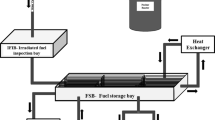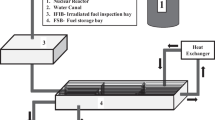Abstract
A spent nuclear fuel (SNF) pool is a key facility for safe management of nuclear waste, where spent nuclear fuel rods are stored in a water pool. The spent fuel rods carry a significant amount of radioactivity; they are either recycled or stored for further processing. Pool water acts as a heat sink as well as a shield against the radiation present in spent/burned fuel rods. The water used in these pools is filtered by an ultra-filtration process which makes certain the purity of water. As the life span of these pools is approximately 20 to 40 years, the maintenance of pure water is a big challenge. A number of researchers have shown the presence of bacterial communities in this ultrapure water. The bacterial types present in SNF pool water is of increasing interest for their potential bioremediation applications for radioactive waste. The present study showed the isolation of six bacterial species in the SNF pool water samples, which had significant radio-tolerance (D10 value 248 Gy to 2 kGy) and also biofilm-forming capabilities. These strains were also investigated for their heavy metal removal capacity. Maximum biofilm-mediated heavy metal (Co and Ni) removal (up to 3.8 μg/mg of biomass) was observed by three isolates (FPB1, FPB4, and FPB6). The ability of these bacterial isolates to survive in radioactive environments can be of great interest for remediation of radioactive contaminants.







Similar content being viewed by others
References
Abiola C, Oyetayo VO (2016) Isolation and biochemical characterization of microorganisms associated with the fermentation of Kersting’s groundnut (Macrotyloma geocarpum). Res J Microbiol 11:47–55
Akintokun AK, Adeyosoye OI, Abiola-Olagunju O, Joel EO (2014) Identification and occurrence of heterophilic rumen bacteria and fungi isolated from selected Nigerian breeds of cattle. J Appl Environ Microbiol 2:303–308
Austrian R (1960) The gram stain and the etiology of lobar pneumonia, an historical note. Bacteriol Rev 24:261–265
Azevedo NF, Pacheco AP, Keevil CW, Vieira MJ (2004) Nutrient shock and incubation atmosphere influence recovery of culturable Helicobacter pylori from water. Appl Environ Microbiol 70:490–493
Bruhn DF, Frank SM, Roberto FF, Pinhero PJ, Johnson SG (2009) Microbial biofilm growth on irradiated, spent nuclear fuel cladding. J Nucl Mater 384:140–145
Chen KC, Ting K, Li YC, Chen YY, Cheng WK, Chen WC, Liu CT (2010) A study of the probabilistic risk assessment to the dry storage system of spent nuclear fuel. Int J Pres Ves Pip 87:17–25
Chen Y-S, Yuann Y-R (2017) Evaluation of cooling capacity with more fuel stored in the spent fuel pool of the Kuosheng plant. Ann Nucl Energy 109:120–134
Cheng S, Tian J, Chen S, Lei Y, Chang X, Liu T, Yin Y (2009) Microbially influenced corrosion of stainless steel by marine bacterium Vibrio natriegens: (I) corrosion behavior. Mater Sci Eng C 29:751–755
Chicote E, Garcia AM, Moreno DA, Sarro MI, Lorenzo PI, Montero F (2005) Isolation and identification of bacteria from spent nuclear fuel pools. J Ind Microbiol Biotechnol 32:155–162
Chicote E, Moreno DA, Garcia AM, Sarro MI, Lorenzo PI, Montero F (2004) Biofouling on the walls of a spent nuclear fuel pool with radioactive ultrapure water. Biofouling 20:35–42
Dey PK, Bansal NK (2006) Spent fuel reprocessing: a vital link in Indian nuclear power program. Nucl Eng Des 236:723–729
Donlan RM (2002) Biofilms: microbial life on surfaces. Emerg Infect Diseases 8:881–890
Donlan RM, Costerton JW (2002) Biofilms: survival mechanisms of clinically relevant microorganisms. Clin Microbiol Rev 15:167–193
Folsom JP, Siragusa GR, Frank JF (2006) Formation of biofilm at different nutrient levels by various genotypes of Listeria monocytogenes. J Food Prot 69:826–834
Kulakov LA, McAlister MB, Ogden KL, Larkin MJ, O’Hanlon JF (2002) Analysis of bacteria contaminating ultrapure water in industrial systems. Appl Environ Microbiol 68:1548–1555
Macfarlane A (2001) Interim storage of spent fuel in the United States. Annu Rev Energ Env 26:201–235
Matsuda N, Agui W, Tougou T, Sakai H, Ogino K, Abe M (1996) Gram-negative bacteria viable in ultrapure water: identification of bacteria isolated from ultrapure water and effect of temperature on their behavior. Colloids Surf B 5:279–289
Mattimore V, Battista JR (1996) Radioresistance of Deinococcus radiodurans: functions necessary to survive ionizing radiation are also necessary to survive prolonged desiccation. J Bacteriol 178:633–637
Meliani A, Bensoltane A (2016) Biofilm-mediated heavy metals bioremediation in PGPR Pseudomonas. J Bioremediat Biodegrad 7:370
Mittelman MW (1991) Bacterial growth and biofouling control in purified water systems. In: Flemming H-C, Geesey GG (eds) Biofouling and biocorrosion in industrial water systems: proceedings of the international workshop on industrial biofouling and biocorrosion, Stuttgart, September 13–14, 1990. Springer, Berlin, pp 133–154
Moreira RG, Ekpanyaskun N, Braby LA (2010) Theoretical approach for the calculation of radiation D10-value. J Food Process Eng 33:314–340
Nakajima A, Sakaguchi T (1986) Selective accumulation of heavy metals by microorganisms. Appl Microbiol Biotechnol 24:59–64
Оgnerubov V, Кaliatka А, Vileiniškis V (2014) Features of modelling of processes in spent fuel pools using various system codes. Ann Nucl Energy 72:497–506
Rao T, Kora AJ, Chandramohan P, Panigrahi B, Narasimhan S (2009) Biofouling and microbial corrosion problem in the thermo-fluid heat exchanger and cooling water system of a nuclear test reactor. Biofouling 25:581–591
Santo Domingo WJ, Berry JC, Summer M, Fliermans BC (1998) Microbiology of spent nuclear fuel storage basins. Curr Microbiol 37:387–394
Serrano-Fujarte I et al (2015) Influence of culture media on biofilm formation by Candida species and response of sessile cells to antifungals and oxidative stress. Biomed Res Int 2015:15
Shukla SK, Rao TS (2017) An improved crystal violet assay for biofilm quantification in 96-well microtitre plate. bioRxiv. https://doi.org/10.1101/100214
Wolfram JH, Mizia RE, Jex R, Nelson L, Garcia KM (1996) The impact of microbially influenced corrosion on spent nuclear fuel and storage life. University of North Texas Libraries, Digital Library, digitallibraryuntedu; crediting UNT Libraries Government Documents Department
Wu X, Li W, Zhang Y, Tian W, Su G, Qiu S (2014) Analysis of the loss of pool cooling accident in a PWR spent fuel pool with MAAP5. Ann Nucl Energy 72:198–213
Xiong Z, Wang M, Gu H, Ye C (2015) Experimental study on heat pipe heat removal capacity for passive cooling of spent fuel pool. Ann Nucl Energy 83:258–263
Acknowledgements
Authors are very thankful to the fuel pool in-charge, SNF, and MAPS for providing water samples. Authors are also thankful to Dr. P. Chandramohan, WSCD, Kalpakkam, for the physicochemical analysis and Dr. Abdul Nishad P., WSCD, Kalpakkam, for the ICP-AES analysis.
Author information
Authors and Affiliations
Corresponding author
Additional information
Responsible editor: Robert Duran
Rights and permissions
About this article
Cite this article
Karley, D., Shukla, S.K. & Rao, T.S. Isolation and characterization of culturable bacteria present in the spent nuclear fuel pool water. Environ Sci Pollut Res 25, 20518–20526 (2018). https://doi.org/10.1007/s11356-017-0376-5
Received:
Accepted:
Published:
Issue Date:
DOI: https://doi.org/10.1007/s11356-017-0376-5




